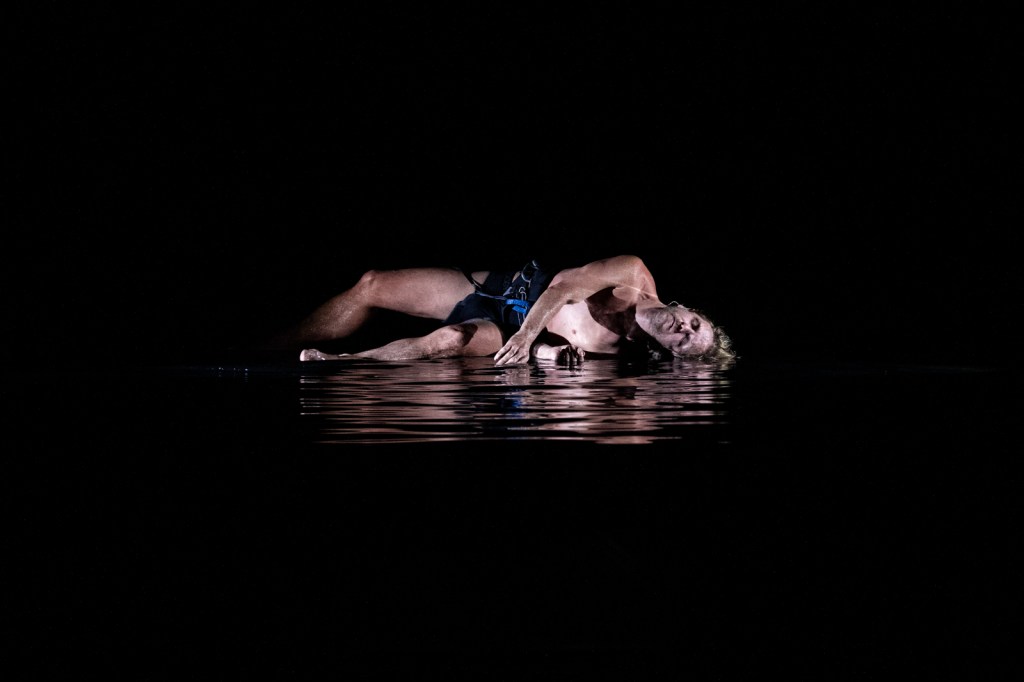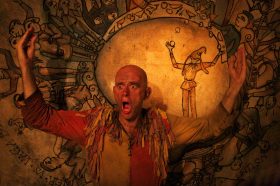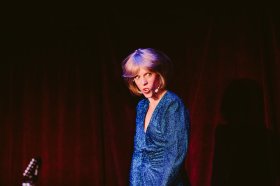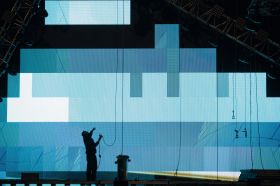As Perth Festival rolled into its second week, Equations of a Falling Body, a relatively low-budget avant-garde work of contemporary dance, was a welcome extension to the Festival’s predominant focus on works of scale and popular appeal. It was a bold act of programming that demonstrated how Festival director Iain Grandage’s personal ethos of cultural democracy includes works that demand more of audiences, ask less in terms of resources and offer local and independent artists fresh opportunities.
Perth choreographer and director Laura Boynes’ new work was a Perth Festival commission. The title alluded to the festival theme of Djinda – the stars and the cosmos – but it did so in a more abstract, process-oriented, comical and even anxious way than other works in the Festival program.
In fact, comedy and anxiety are states of mind (and body) that this work aroused in (and imposed on) its three performers – dancers James O’Hara and Ella-Rose Trew and actor/physical performer Tim Green. Each of them had a distinctive movement style and stage persona – O’Hara more loosely expressive, Trew more tautly contained and Green more flexible and clown-like.
However, all three swapped functional roles in the course of the show and progressively developed their sense of individual and collective engagement as they spontaneously interpreted the sequence of enigmatic instructions they were given via earpieces by Boynes, who sat at one side of the stage whispering into a head mic.
Their interpretations were often hilarious but also resulted in images of beauty, terror and sadness. The process reminded me of the surrealist game of ‘exquisite corpse’ in which each player adds to the contribution of his or her predecessor without knowing what comes next, so that a kind of spontaneous visual logic and poetry unfolds without any apparent overarching plan or divine intervention – apart from the tasks and structures put in place by the director/choreographer, who also appeared to be responding spontaneously to the work of the performers.
There was a strong sense of agency – and urgency – but also of inevitable failure and even powerlessness on the part of the performers in the face of the ongoing stream of instructions. I felt like I was watching a trio of hapless fools attempting to handle and deal with some kind of historical catastrophe, and was reminded of Beckett: ‘Try again, fail again, fail better.’
The motif of ‘falling bodies’ was repeatedly invoked, along with acts of hiding and revealing, denial, frustration, anxiety, desperation, surrender and resignation, counterbalanced by an ongoing sense of mutual trust, support and care. Beneath it all I felt a growing sense of helplessness and even grief that I couldn’t help associating with the era we’re living through, as clumsy and vulnerable beings in a broken and abandoned world that we’ve been given the seemingly impossible task of putting right.
The overall form of the work could only sporadically be described as ‘dance’, though there was undeniably dance and movement in the work. It was more like a kind of bricolage, with the performers also acting as their own stagehands, dragging onstage and manipulating a collection of large and often unwieldy objects and materials, such as giant fans, lengths of carpeting or rolls of silver sunshield reflective covering, as well as technical gadgets like headtorches and loudhailers.
Bruce McKinven’s evolving set and costumes were similarly practical and utilitarian: the black curtains, walls and floor of the venue, black clothes and underwear, knee pads, gloves, tape, earpieces and battery packs. Matt Marshall’s lighting was similarly minimal and mostly monochrome.
Initially – and perhaps inevitably given the task-based improvisatory form – there were some uneven and bumpy sections, deliberately underlined by abrupt blackouts followed by house lights snapping up. However, the performance gradually revealed an underlying sense of unity and flow, no doubt due to the deep sense of collaboration between the performers, the ceaseless flow of inspiration coming from Boynes, the overarching functional aesthetic of McKinven’s and Marshall’s visual designs, and the carefully structured emotional progression of Felicity Groom and Tristan Parr’s music and sound design, culminating in a heart-stopping sequence choreographed/improvised to Saint-Saëns’ ‘Mon coeur s’ouvre à ta voix’ (‘My heart opens to your voice’) from Samson et Dalila – the title of the aria perfectly encapsulating the work’s methodology and underlying ethos.
Read: Theatre review: The Wharf Revue: Looking for Albanese, QPAC
The work of the performers was astonishing in its openness, honesty, fearlessness and tenderness, and required a similar spirit from the audience – to laugh, to accept, to wonder and to grieve. It’s rare to see something as daring and risky as this, especially in a festival setting, and I applaud everyone involved – but especially Boynes, for having the courage and vision to expose and embrace the unknown, in all its nakedness and terror.
Equations of a Falling Body
Perth Studio Underground
Choreographer and director: Laura Boynes
Sound designers and composers: Felicity Groom and Tristen Parr
Set and costume designer: Bruce McKinven
Lighting designer: Matt Marshall
Movement consultant: Adelina Larsson
Dramaturg: Anthony Coxeter
Mentor and outside eye: Lucy Guerin
Manager: Mark Haslam
Stage manager: Riley Billyeald
Lighting realiser: Peter Young
Performers: Ella Rose Trew, James O’Hara and Timothy Green
Equations of a Falling Body was performed from 21-26 February as part of Perth Festival.





